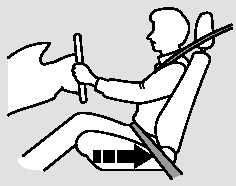Honda CR-V: Adjust the Front Seats

Adjust the driver’s seat as far to the rear as possible while allowing you to maintain full control of the vehicle.
Have a front passenger adjust their seat as far to the rear as possible.
If you sit too close to the steering wheel or dashboard, you can be seriously injured by an inflating front airbag, or by striking the steering wheel or dashboard.
The National Highway Traffic Safety Administration and Transport Canada recommend that drivers allow at least 10 inches (25 cm) between the center of the steering wheel and the chest. In addition to adjusting the seat, you can adjust the steering wheel up and down, and in and out.
If you cannot get far enough away from the steering wheel and still reach the controls, we recommend that you investigate whether some type of adaptive equipment may help.

Sitting too close to a front airbag can result in serious injury or death if the front airbags inflate.
Always sit as far back from the front airbags as possible.
On vehicles with manual adjustable seats
Once your seat is adjusted correctly, rock it back and forth to make sure the seat is locked in position.
See page for how to adjust a front seat (power adjustment) and page for a manual adjustment.

